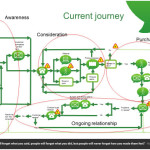Customer retention and the customer journey
Retaining your customers is about meeting or exceeding their expectations. You never want to give them a reason to stop using you. So, how do you do that?
Well, for me it’s about the customer journey – mapping and understanding it. That means you can be sure about the customer need at every stage of the journey. Only then can you make sure you have the right things in place at the right time for each customer.
Journey mapping is an art (with a lot of science behind it!). It works best when an expert does it (yes, I know you expected me to say that!), but here are some simple things you can do:
First, think about the start of the customer journey. This is when someone becomes aware of your business and starts to consider buying from you. It’s where most businesses spend most of their time and money to attract new customers. It’s also where you set customer expectations through promises about your products and service. Check you don’t over-promise. If you set high expectations of products and service you need to be sure you can meet or exceed them. Otherwise your customers will soon feel let down and start looking for another supplier.
This also means you shouldn’t have offers that are only available for new customers. All they do is set an expectation of low prices in the future and annoy existing customers. That’s because they see that you value new customers more than you value them!
Next, think about when an existing customer will buy from you again. You already have a lot of information about them so make sure you use it. Simple things like pre-populating forms to save the customer time work well. Don’t put an existing customer through the same process as a new customer – let them see that you remember them!
Even better, try to work out when they might need you. For example, a printer may sell someone 500 business cards and get a repeat order 6 months later. A clever printer will work out that the customer gets through 500 cards every 6 months. 5 months after an order they will contact the customer and ask if they need more cards. It makes it easy for the customer, shows you understand their needs and increases sales.
Next, think about when they may need to contact you with a query. Make sure they have the information they need before they call you! It always improves customer loyalty. Make sure the quality of your communications is consistent as well. A monthly statement should look just as good as the sales brochure that made them a customer in the first place. If they do need to contact you, make sure they can talk to a person – on or offline. Online customers are invisible to you (and you to them). The lack of visual and tactile presence means it is key to create a sense of personal connection.
When you do communicate, use different channels. E-mails are cost effective but can lack impact. Using a postcard as a reminder that a service needs booking for example can be much more effective.
Think about why and how the customer will be using your product or service. If it’s something that they will use for a long time, try to work out what stages they will go through and when. Then communicate with them when they may need reminders about how your service can help them.
Keep in touch for regular advice and practical examples about customer experience.
Get in touch to see how we can help your business.
Ask an expert if you have a specific question about customer experience.

